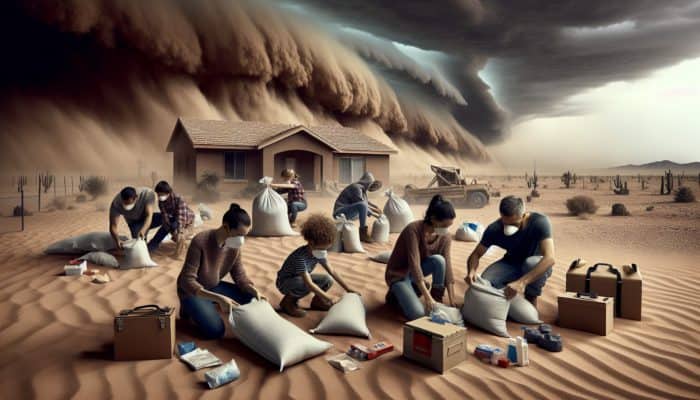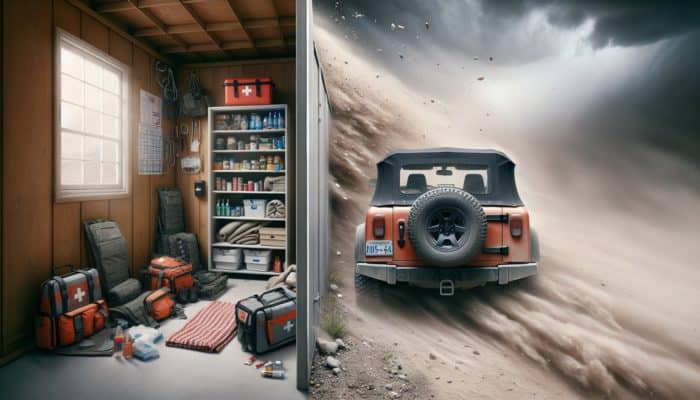Comprehending the Dynamics of Dust Storms
Surviving a Dust Storm: Dust storms present a significant natural phenomenon that can arise unexpectedly, creating major challenges for individuals caught in their trajectory. It is essential to recognise and comprehend these storms, particularly for those residing in regions prone to their impacts. This is especially true in dry areas worldwide, where the consequences can be severe. The importance of implementing effective strategies for surviving a dust storm cannot be overstated, considering their ability to disrupt everyday life and pose considerable health hazards to those affected.
Uncovering the Causes Behind Dust Storms

Dust storms originate from powerful winds that lift loose soil and sand into the atmosphere, predominantly in dry conditions. These storms typically form when a confluence of strong winds and parched ground conditions occurs, especially in desert or semi-arid regions. Locations such as the Sahel in Africa, the Dust Bowl regions of the United States, and various parts of Australia are particularly at risk due to their specific environmental characteristics. Understanding these causes is crucial for anyone living in or traveling through these susceptible areas.
When wind speeds exceed a certain threshold, which can vary based on local geography and soil type, particles of dust and sand become airborne. The atmosphere can carry these particles over considerable distances, sometimes spanning hundreds of miles. This movement can create vast, swiftly approaching walls of dust, drastically reducing visibility to almost zero and presenting severe hazards for anyone caught in their path. The physical and environmental implications of these storms can be profound.
Grasping the fundamental conditions that lead to the emergence of dust storms is crucial for both residents and travellers in affected regions. Meteorological patterns, such as high-pressure systems that induce aridity, can significantly heighten the risk of such storms. Furthermore, human activities—including deforestation and poor agricultural practices—can worsen dust storm conditions by destabilising the soil and diminishing vegetation cover, making it vital to consider both natural and anthropogenic influences.
Identifying Early Signs of Dust Storms
Recognising the early signs of an impending dust storm is vital for timely action. One of the first visual indicators is the appearance of a wall of dust on the horizon, which might resemble a dark cloud or fog. This visual cue often alerts individuals that a dust storm is approaching. As the storm nears, reduced visibility becomes another hallmark; you may notice a significant decline in sight distance, making it challenging to see objects just a short distance away, which can lead to dangerous situations.
Another crucial sign that a dust storm is imminent is a sudden increase in wind speed. Observing a rapid change in wind patterns, particularly if accompanied by dry conditions, necessitates immediate action. Dust storms can develop rapidly with little warning, and recognising these visual and sensory cues can significantly enhance your preparedness and response capabilities. Awareness and vigilance are key components in ensuring safety during such events.
Meteorological forecasts can also provide invaluable insights into potential dust storm activity. Numerous weather services offer alerts and predictions based on prevailing conditions, wind patterns, and historical data. Monitoring these forecasts enables individuals and communities to anticipate and prepare effectively for dust storms, ensuring that appropriate safety measures are established before the storm strikes and thereby reducing potential harm.
Anticipating the Arrival of Dust Storms
While meteorological forecasts can accurately predict dust storms, sudden fluctuations in weather can also serve as indicators of their approach. Many regions that are frequently affected by dust storms, such as the Middle East and North Africa, have developed sophisticated systems for monitoring atmospheric conditions. The use of satellite imagery and weather radar provides real-time data that can help predict storm occurrences, enhancing preparedness.
Local meteorological stations frequently issue dust storm warnings, enabling communities to prepare and respond effectively to these events. For instance, in regions subjected to seasonal dust storms, such as the Khamsin winds in Egypt, residents can take precautionary measures, including preparing emergency plans and staying indoors during peak storm activity, to ensure their safety.
Remaining informed about weather patterns and leveraging available resources is essential for mitigating the effects of dust storms. Engaging with local weather services, utilising apps that deliver real-time updates, and participating in community alert systems can significantly enhance your preparedness and response strategies during these potentially hazardous conditions.
Essential Preparations for Dust Storms

Preparation is fundamental to effectively surviving a dust storm. By adopting the right strategies and assembling necessary supplies, individuals can significantly mitigate the risks associated with these powerful weather events. The subsequent steps outline crucial preparations that individuals and families should undertake to enhance their safety and resilience.
Assembling a Comprehensive Emergency Kit
An emergency kit is an indispensable resource for anyone residing in or travelling through areas prone to dust storms. Your kit should include essential items, such as water, non-perishable food, a flashlight, first-aid supplies, and a dust mask to protect against inhaling harmful particles. Water is particularly critical, as dehydration can become a serious concern during a dust storm, especially if you find yourself outdoors when one strikes.
It is advisable to stock your emergency kit with sufficient supplies to last at least three days. Include items such as canned goods, dried fruits, or protein bars, which can provide essential energy without the need for cooking. Furthermore, having a reliable flashlight or battery-powered lantern can prove invaluable, especially if the storm results in power outages, ensuring that you can navigate safely in low-light conditions.
Consider also incorporating a portable phone charger into your kit. During emergencies, maintaining communication and receiving updates is crucial for your safety. Additionally, remember to review your emergency kit at least once a year to ensure all items are in good condition and that food and water supplies remain viable for use in an emergency.
Fortifying Your Home Against Dust Storms
Before a dust storm arrives, it is essential to prepare your home to minimize the amount of dust that can infiltrate. Close all windows and doors securely, sealing any gaps that could allow dust to enter. Utilizing weatherstripping can enhance your home’s seals, and covering air vents or intakes can prevent dust from being circulated indoors, thereby improving air quality during storms.
In addition to securing your home, it is prudent to prepare your outdoor spaces. Relocate lightweight furniture and decorations indoors, and secure heavier items that could become airborne in strong winds. If you have a garden, consider covering it with tarps or blankets to shield plants and soil from the harsh effects of dust, thereby preserving their integrity and health.
Creating a dust storm preparedness checklist can help ensure that you don’t overlook any critical steps in your preparations. This checklist may include tasks such as verifying your ventilation systems and ensuring that your home’s air filtration systems are functioning properly. A clean filter can be instrumental in maintaining indoor air quality during and after a dust storm.
Ensuring Your Vehicle is Ready for Dust Storms

Your vehicle can serve as a haven during a dust storm if it is adequately prepared. Whenever possible, park your vehicle in a sheltered area, such as a garage or a covered parking space. If indoor parking is not feasible, select a location that is distant from trees and structures that may collapse or shed branches during the storm.
Close all windows tightly and turn off the air conditioning to prevent dust from being drawn into the vehicle. Soft-top vehicles, particularly convertibles, are especially vulnerable during dust storms; if you own one, consider finding a hardtop vehicle or a secure shelter to protect it from potential damage.
If you find yourself driving during a dust storm, it is essential to ensure that your vehicle’s windshield wipers are in good working condition. This preparation can significantly enhance your visibility should rain accompany the storm. Always keep emergency supplies, such as water and a first-aid kit, in your vehicle at all times to ensure you are ready for any eventuality that may arise.
Keeping Updated on Weather Conditions
Staying informed about weather conditions is crucial for effective preparation for dust storms. Regularly check weather reports, utilise weather apps, and listen to local radio stations for updates on potential dust storms. Many meteorological services provide alerts via text or email, offering timely notifications about impending storms and enabling proactive measures to be taken.
Engaging with community forums and social media groups focused on weather updates can significantly enhance your knowledge and preparedness. Sharing experiences and practical tips with others can help build a supportive network that strengthens community resilience during challenging weather events.
Moreover, consider investing in a weather radio that broadcasts emergency information. This device can be invaluable during power outages, ensuring that you receive crucial updates regarding storm conditions and safety recommendations. Remaining connected and informed during a dust storm can greatly influence your ability to navigate these events successfully and safely.
Safeguarding Livestock and Pets During Dust Storms
For those residing in rural areas where livestock and pets are prevalent, it is paramount to prepare them adequately for dust storms. Ensure that all animals have access to secure shelter where they can be protected from flying debris and dust. Buildings should be robust and well-ventilated, providing a safe environment for animals during and after a storm.
Access to clean water is essential during a dust storm, as dust can contaminate water sources, making them unsafe for consumption. Consider establishing multiple water supplies in sheltered areas to guarantee that animals remain hydrated throughout the storm.
For household pets, bringing them indoors during a storm, if feasible, is advisable. Create a safe space for them to remain calm and secure, providing familiar items such as blankets or toys to help alleviate stress during the storm. Taking these precautions demonstrates a commitment to their well-being and safety during these challenging weather events.
Strategies for Staying Safe During Dust Storms
When a dust storm strikes, knowing how to respond swiftly can save lives and minimise health risks. Here are essential strategies to employ for maintaining safety during these formidable weather events.
Immediate Shelter Seeking During Dust Storms
The foremost rule during a dust storm is to seek shelter immediately. If you find yourself outdoors, try to locate a sturdy building or a vehicle for protection. Avoid staying in open areas, as the wind can propel debris and dust in your direction, leading to significant injury risks.
If driving during a dust storm is unavoidable, remain calm and avoid panicking. Slow down to maintain control of your vehicle; visibility may decrease rapidly. If visibility drops to zero, safely pull over to the side of the road, turn off your headlights, and stay inside your vehicle until the storm passes. This approach is crucial for preventing accidents and reducing exposure to harmful dust particles.
For those in homes or buildings, ensure that windows and doors are sealed tightly to prevent drafts from entering. Turn off the air conditioning and fans that could draw in dust. If you experience respiratory difficulties, wearing a dust mask or covering your nose and mouth with a cloth can help filter out harmful particles and protect your health.
Prioritising Respiratory Protection
During a dust storm, safeguarding your respiratory system is of utmost importance. Dust particles can lead to various health issues, particularly for individuals with pre-existing conditions such as asthma or chronic obstructive pulmonary disease (COPD). Wearing a dust mask or a cloth over your nose and mouth can significantly decrease the risk of inhaling harmful particles.
It is advisable to stay indoors as much as possible during a dust storm, especially for vulnerable individuals, such as children and older people. If available, use air purifiers to help filter out dust particles and enhance indoor air quality. If you lack access to an air purifier, keeping windows closed and using damp cloths to wipe down surfaces can help manage indoor dust levels effectively.
Monitoring your health during and after the storm is critical. If you experience persistent coughing or difficulty breathing, seek medical attention promptly. Being proactive about your health during these events can help prevent long-term complications associated with dust inhalation, ensuring your overall well-being.
Maintaining Calm and Staying Informed
Amidst the chaos of a dust storm, remaining calm and informed is vital for effective decision-making. Pay attention to local emergency broadcasts for updates and follow any instructions from the authorities. Staying connected with neighbours can also be beneficial; sharing information and experiences can provide additional guidance and support during these tumultuous times.
Engaging in calming activities, such as reading or listening to music, can help reduce anxiety levels. Maintaining a composed mindset enables better decision-making, particularly in emergencies. Focus on your preparedness efforts and ensure that all household members are accounted for and safe, thereby fostering a sense of security and peace of mind.
Establishing a communication plan with family members can help alleviate panic and ensure everyone understands what to do during a storm. Designating a meeting point in case of separation can provide reassurance to all involved, enhancing overall safety.
Effectively Navigating Through Dust Storms
When you find yourself amidst a dust storm, knowing how to navigate safely is crucial to safeguarding yourself and others. These strategies will guide you through the challenging conditions presented by dust storms.
Safe Driving Practices During Dust Storms
If driving during a dust storm is necessary, prioritise safety above all else. Reduce your speed significantly; visibility can diminish drastically within moments. Use your headlights to enhance visibility, but avoid using high beams, which can reflect off the dust and worsen visibility conditions further.
If conditions become excessively severe, pull over to a safe location—preferably one that is away from trees, power lines, and other vehicles. Turn off your headlights and remain inside your vehicle. This strategy diminishes the chances of an accident and keeps you protected from airborne debris and dust.
Avoid making sudden movements that could cause you to lose control of your vehicle. Maintain a safe distance from other cars; limited visibility can lead to unexpected stops or slowdowns. Consider tuning in to local traffic reports for updates on road conditions during the storm.
Utilising Navigation Aids Effectively
Relying on GPS or other navigation aids is vital when navigating through a dust storm. However, be prepared for sudden changes in visibility that may disrupt your ability to follow directions accurately. Ensure that your navigation devices are charged and easily accessible at all times.
In severe storm conditions, consider postponing your journey until visibility improves. It is often safer to remain stationary than to risk driving under dangerous visibility conditions.
If you find yourself lost, do not panic. Familiarise yourself with general landmarks, local maps, or even utilise offline maps available in various applications. Planning routes that avoid areas known for severe dust storm activity can enhance your safety in the future.
Avoiding Potential Hazards During Dust Storms
Dust storms can introduce various hazards, including fallen debris, power lines, and slowed or stalled vehicles. If you are navigating during a storm, stay alert for these potential dangers. Keep your surroundings in check and avoid areas with significant debris or hazards that could pose a threat to your safety.
If you encounter fallen trees or power lines, report them immediately to the relevant authorities. Do not attempt to address the situation yourself, as many hazards can pose considerable risks to personal safety and well-being.
In addition to natural hazards, be mindful of other vehicles on the road. Watch for cars that may have come to a sudden stop due to low visibility. Maintaining a safe distance from other vehicles can help prevent collisions or accidents during these challenging conditions.
Wearing protective gear is essential during a dust storm. Donning goggles will shield your eyes from dust particles and debris. Pairing goggles with masks or cloths can help filter out harmful dust, providing a comprehensive approach to staying safe during these challenging weather events.
Implementing Personal Protection Measures
Ultimately, safeguarding yourself during a dust storm requires proactive measures. Use a mask or cloth over your nose and mouth to filter out dust particles, which can aggravate health issues. Additionally, goggles can help protect your eyes from both dust and flying debris, enhancing your safety.
If you must be outdoors, limit your exposure as much as possible. Seek sheltered areas and remain low to the ground when conditions worsen. Staying low reduces the risk of inhaling large amounts of dust and protects your body from airborne debris and particulate matter.
After the storm has passed, it is advisable to allow time for the dust to settle before venturing outside. The air may remain hazardous for hours or even days following a storm due to lingering particles. Consulting local air quality reports can help determine when it is safe to resume outdoor activities.
Post-Dust Storm Recovery Steps
Once a dust storm has subsided, the focus shifts to recovery and evaluating the impacts on your environment and personal well-being. Here are the critical steps to undertake following a dust storm event.
Evaluating Damage Post-Storm
After the storm has passed, it is essential to inspect your home and vehicle for any damage that may have been sustained during the storm. Check for broken windows, damaged roofs, or any structural issues that may require immediate attention. Documenting damage with photographs can be beneficial for insurance claims and repair assessments, providing a clear record of the impacts.
Your vehicle also requires a thorough inspection. Dust can accumulate on surfaces, leading to potential issues if not addressed promptly. Inspect the engine, filters, and exterior for signs of debris accumulation. Scheduling a comprehensive maintenance check can ensure that your vehicle remains safe and functional following the storm.
Evaluate your surroundings, particularly if you reside in areas with numerous trees or vegetation. Falling branches or uprooted plants can generate hazards in your yard. Addressing any issues promptly can prevent future complications, ensuring a safer environment for all.
Safely Cleaning Up After Dust Storms
Cleaning up in the aftermath of a dust storm necessitates careful consideration for health and safety. Wearing protective gear, including masks and gloves, is crucial to shield yourself from dust exposure while sweeping or cleaning surfaces.
Start by removing large debris or dust accumulated on driveways, walkways, and outdoor areas. Utilise a damp cloth or mop to wipe down surfaces inside your home, which can help reduce dust levels effectively. Consider using a vacuum equipped with a HEPA filter for thorough indoor cleaning, targeting fine dust particles.
Dispose of waste responsibly, ensuring compliance with local regulations regarding hazardous materials. If debris includes broken glass or sharp objects, handle them with extreme care to avoid injury. Adopting these precautions can streamline the cleanup process and maintain a safe and healthy environment.
Restoring Normalcy After a Dust Storm
Returning to regular activities following a dust storm may take time, and it is vital to approach this process gradually. Assess your environment and complete any necessary repairs before resuming your regular routines to ensure safety and comfort.
Communicating with family members about their experiences during the storm is important. Sharing feelings can foster emotional support and help everyone adapt to the aftermath of the event, promoting collective healing and recovery.
As you reintegrate into daily life, ensure all safety measures are in place and that any required repairs have been completed. For communities, organising support groups or cleanup initiatives can foster resilience and encourage collective rebuilding efforts in the wake of a dust storm event.
Long-Term Dust Storm Preparedness Strategies
Being prepared for future dust storms necessitates ongoing education and a commitment to readiness. Establishing long-term strategies can enhance your ability to adapt to these events effectively.
Educating Your Family on Dust Storm Safety
Teaching family members about dust storm safety is essential for cultivating a culture of preparedness. Involve children in discussions about dust storms, their potential impacts, and how to recognise the early signs and appropriate responses in an emergency.
Developing a family emergency plan that outlines roles and responsibilities can empower everyone to act effectively in the event of a storm. Practicing drills can reinforce these concepts, ensuring that everyone understands what to do if they find themselves in a dust storm situation.
Consider engaging with local community programmes or workshops focused on weather preparedness. These educational resources can enhance your family’s understanding and readiness for future dust storms, fostering a proactive approach to safety.
Maintaining Your Emergency Supplies
Regularly checking and replenishing your emergency kit is crucial to ensuring it remains ready for use. Establish a schedule for assessing supplies, particularly perishable items like food and water, which often have expiration dates. Replace expired items and ensure all equipment, such as flashlights and batteries, is functional and ready for action.
Consider expanding your emergency supplies to include additional items, such as a portable phone charger, emergency blankets, and a multi-tool. A well-stocked kit significantly enhances your ability to respond effectively to any situation that may arise during a dust storm or other emergencies.
Maintaining supplies is not merely a one-time task; it requires ongoing commitment to preparedness. By developing a routine for checking and restocking your emergency kit, you can ensure that it remains functional and ready for immediate use at all times.
Staying Informed About Dust Storm Risks
Staying informed about weather forecasts and emergency alerts is vital for future dust storm preparedness. Subscribe to local news outlets, weather apps, and community alert systems that provide real-time updates on weather conditions, ensuring you are always aware of potential risks.
Engaging with local meteorological services and participating in community discussions can also enhance your understanding of potential dust storm risks and preparedness strategies. Consider sharing this information with neighbours to foster a network of preparedness, thereby strengthening community resilience.
By prioritising education and remaining vigilant, you can ensure that you are equipped to face future dust storms confidently and effectively, safeguarding your health and well-being.
The Role of Communities in Dust Storm Preparedness
Communities play a pivotal role in addressing the challenges posed by dust storms. Collaborative efforts can significantly enhance preparedness and recovery, ensuring that everyone has the necessary support during such events.
Fostering Community Support During Dust Storms
Supporting neighbours during dust storms cultivates a sense of solidarity and resilience within communities. Check on elderly or vulnerable individuals in your area, offering assistance in preparing for storms or helping with cleanup afterward to foster a spirit of cooperation.
Creating a network of support can enhance preparedness and facilitate the sharing of resources. Establish community groups focused on dust storm awareness; providing educational resources and sharing experiences can help others in need, ensuring that no one faces these challenges alone.
Moreover, organising community drills and preparedness workshops ensures that everyone understands the necessary steps to take during a dust storm. Engaging in these activities strengthens community bonds and enhances collective resilience, preparing everyone for future events.
Community-Level Preparations for Dust Storms
Communities can mitigate the impact of dust storms by understanding necessary precautions and preparations. Local governments should collaborate to secure infrastructure and develop emergency plans that address the specific risks associated with dust storms.
Community education initiatives can focus on raising awareness about best practices for dust storm preparedness and mitigation. Workshops can cover topics such as emergency kit preparation, home securing techniques, and strategies for effective weather monitoring, empowering residents with the knowledge they need.
Encouraging local businesses to adopt dust storm preparedness plans can further enhance community resilience. By creating a comprehensive plan that addresses potential dust storm impacts, businesses can ensure they are prepared to serve their customers effectively during challenging times.
Coordinating Community Recovery Efforts
After a dust storm, community recovery efforts can play a significant role in restoring normalcy. Establishing cleanup initiatives brings people together, fostering a spirit of collaboration and mutual support as communities work to recover from the impacts of dust storms.
Engaging with local organisations and volunteers can enhance recovery efforts, ensuring that cleanup and rebuilding processes are efficient and effective. Sharing resources and information among community members can facilitate a smooth recovery process, allowing everyone to rebuild together.
In addition to physical cleanup efforts, communities should also consider providing mental health support, as dust storms can have psychological impacts on residents. Offering counselling services or support groups can help individuals process their experiences and promote positive recovery.
Frequently Asked Questions (FAQs)
What actions should I take if I am caught outside during a dust storm?
If you find yourself outdoors, seek immediate shelter in a sturdy building or vehicle. Avoid driving if possible, and protect your respiratory system by covering your nose and mouth with a cloth to filter out harmful dust particles.
How can I prepare my home effectively for a dust storm?
To prepare your home, ensure that windows and doors are sealed tightly, cover air vents, and secure outdoor furniture and belongings. Create an emergency kit that includes essential supplies such as water, non-perishable food, and a dust mask to protect against inhalation hazards.
What health risks are associated with dust storms?
Health risks from dust storms include respiratory issues, allergies, and eye irritation. Individuals with pre-existing conditions such as asthma may experience exacerbated symptoms, making it crucial to take precautions.
Are dust storms predictable, a nd how can I stay informed?
While meteorological forecasts can predict dust storms with reasonable accuracy, sudden changes in weather conditions may also indicate their approach. Regularly monitoring weather updates is crucial for maintaining preparedness and ensuring safety.
What should I include in my emergency kit for dust storms?
Your emergency kit should contain at least three days’ worth of water and non-perishable food, a flashlight, first-aid supplies, and a dust mask to filter out harmful particles.
How can I ensure my pets’ safety during a dust storm?
Provide secure shelter for pets, ensure they have access to clean water, and bring them indoors if possible. Creating a calm environment can help reduce their stress during the storm.
What immediate actions should I take after a dust storm passes?
After a dust storm, assess your property and vehicle for any damage, clean up safely while wearing protective gear, and gradually restore normal activities once it is deemed safe to do so.
How can communities effectively prepare for dust storms?
Communities can prepare by establishing comprehensive emergency plans, conducting educational workshops, and ensuring that local infrastructure is secure against the impacts of dust storms.
What is the best method to protect my respiratory system during a dust storm?
Utilise a dust mask or a cloth to cover your nose and mouth. Staying indoors as much as possible and avoiding strenuous activities during the storm are also effective protective measures.
Where can I find reliable information about upcoming dust storms?
Check local weather reports, subscribe to emergency alert systems, and utilise weather apps to remain informed about potential dust storms in your region.
Explore our journey on X!
Emergency Family Plan: Universal Preparation Guide
Comprehensive Elements to Include in Your Family Emergency Plan Effective Communication Strategies for Emergencies Emergency Family Plan: Establishing effective communication strategies is absolutely vital for ensuring that family members remain connected and informed during emergencies. It’s crucial to have clear, reliable methods in place that everyone understands and can utilise effortlessly. This encompasses traditional communication […]
Survival Water Bottles: Essential Gear for Emergencies
Why Survival Water Bottles are Essential for Emergency Preparedness Understanding the Significance of Hydration in Crisis Situations Survival Water Bottles: Maintaining hydration is vital for ensuring optimal bodily functions during emergencies. In scenarios where access to clean water is limited, sustaining proper hydration is crucial in preventing health complications associated with dehydration, which can include […]
Water Safety in Crises: Essential Tips and Strategies
The Crucial Role of Water Safety During Crises Identifying Water-Related Risks in Crisis Situations Water Safety in Crises: Crises arising from natural disasters, such as floods and hurricanes, or from human-induced events, like conflicts, frequently heighten water-related risks. During these challenging times, the security and quality of water supplies can be severely compromised, leading to […]
Survival Radio Options: Essential Gear for Emergencies
Comprehensive Guide to Different Types of Survival Radios Portable Handheld Radios for Emergency Situations Survival Radio Options: Portable handheld radios are essential components of any effective survival strategy, providing unparalleled portability and user-friendliness during emergencies. These devices are specifically engineered to be lightweight, making them perfect for activities like hiking, camping, or preparing for unforeseen […]







Ah, the good old dust storm – nature’s way of reminding us to invest in better indoor air purifiers! It’s fascinating how these storms can transform a clear day into a scene straight out of a post-apocalyptic movie, isn’t it? I once got caught in a mini dust storm while hiking in the desert, and let me tell you, nothing prepares you for the moment you realize your socks are now sand-embedded souvenirs. And don’t even get me started on the health impacts; it feels like a bad day for your sinuses and skin all at once.
Isn’t it fascinating how nature can be both awe-inspiring and slightly terrifying? When I think of dust storms, I can’t help but conjure up images of dramatic Westerns—tumbleweeds blowing across the screen, rugged cowboys squinting through the grit. The reality, though, is far less romantic and much more hazardous!
Ah, dust storms! It’s almost as if nature decided to throw a surprise party, but instead of confetti, we get clouds of dirt sweeping through our lives. I grew up in a place that was infamous for its delightful seasonal dust storms, so I’d say I have a bit of experience dodging swirling sand like a middle school dodgeball game.